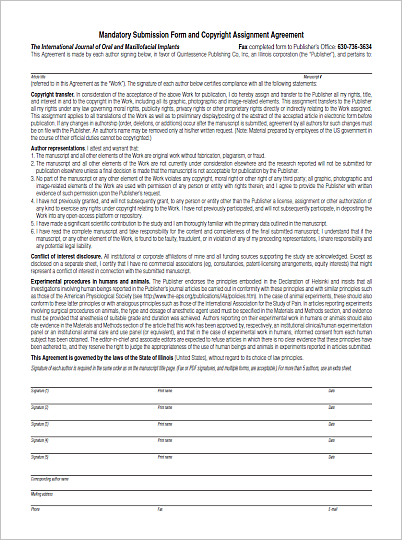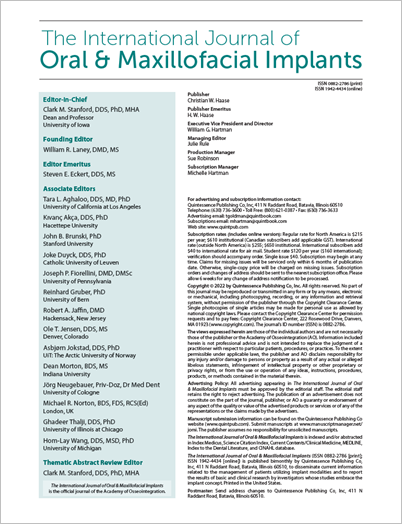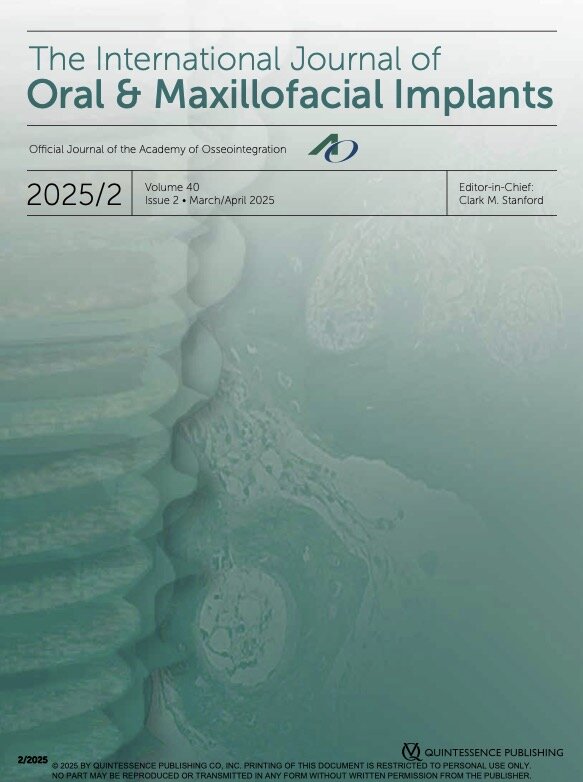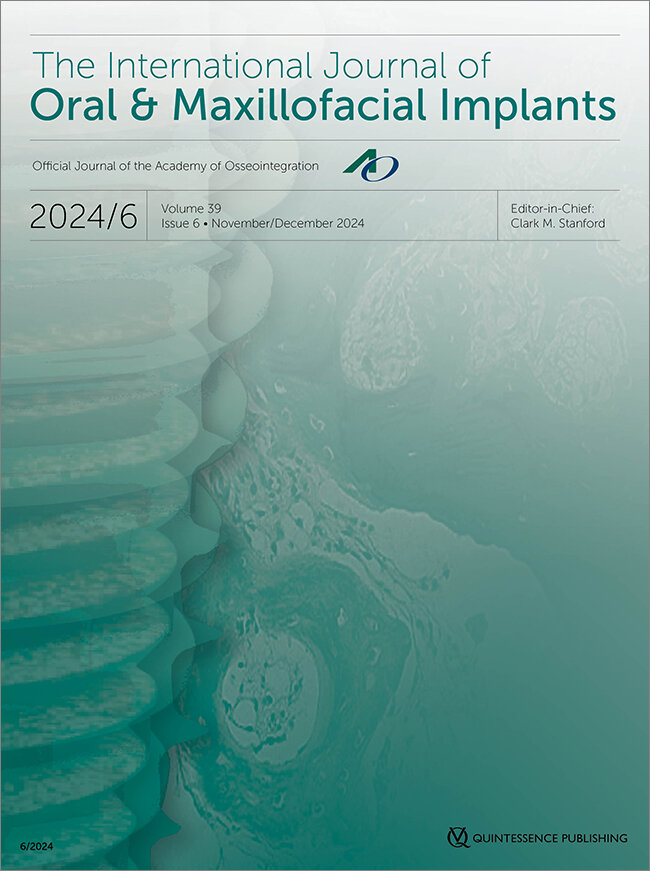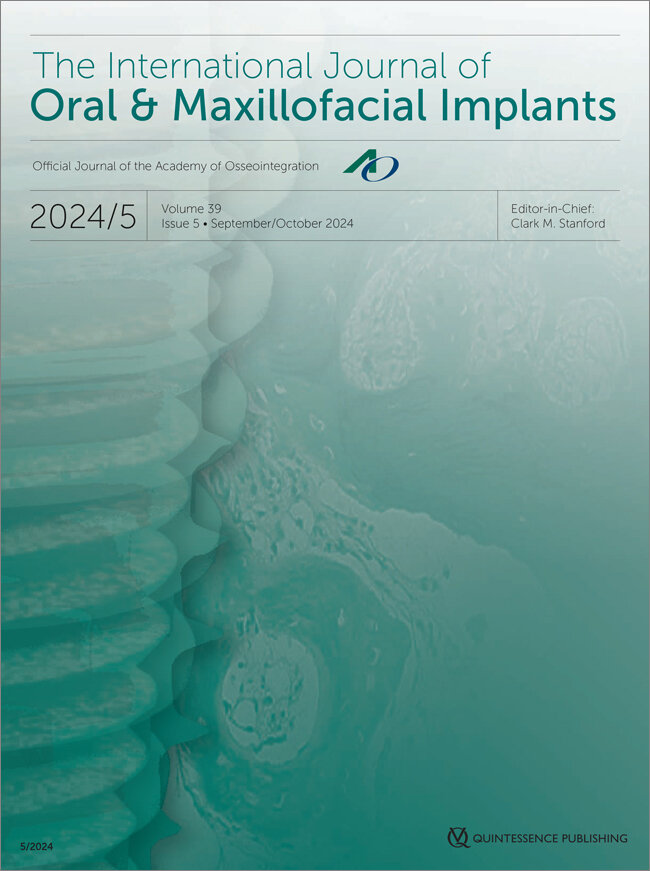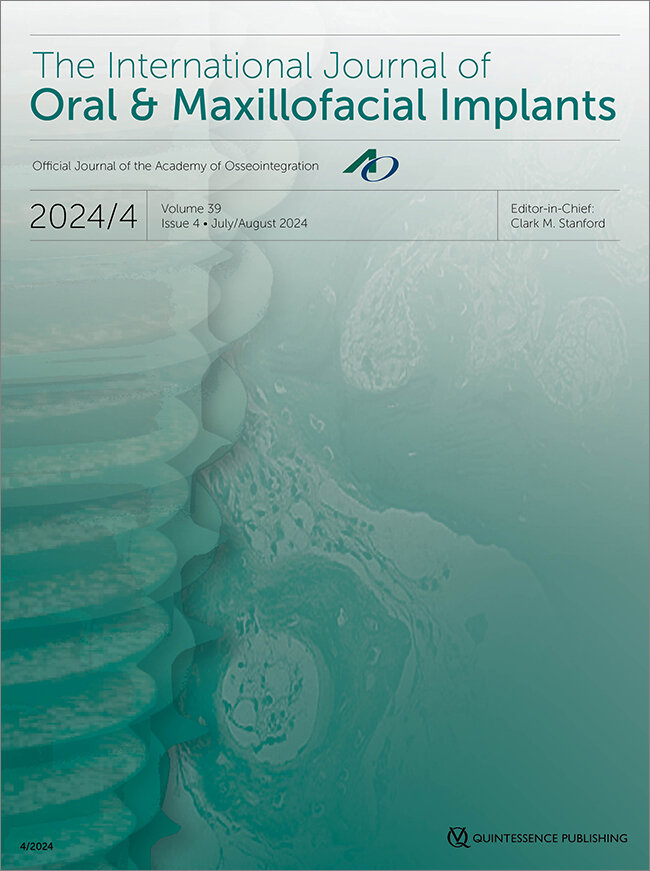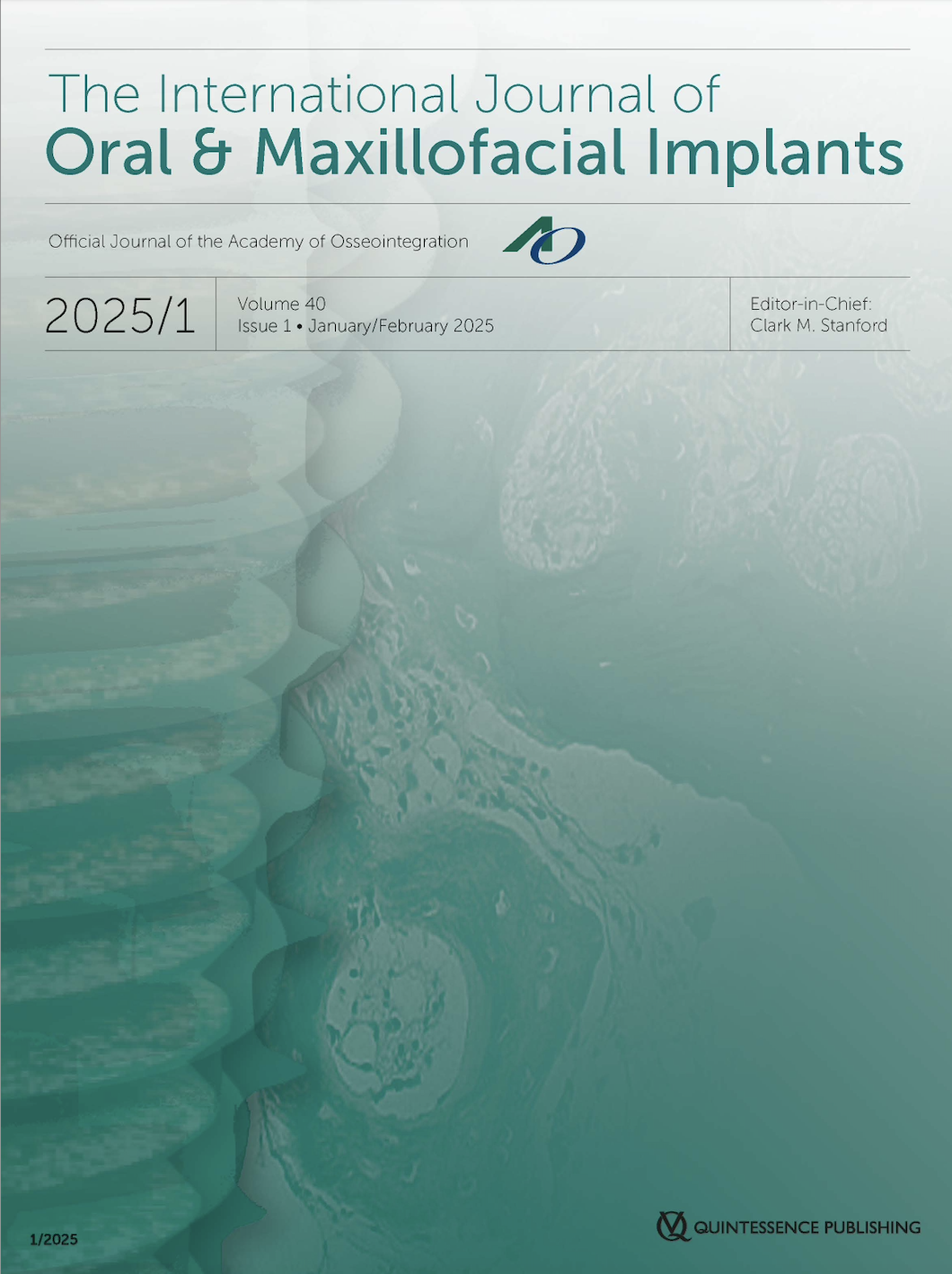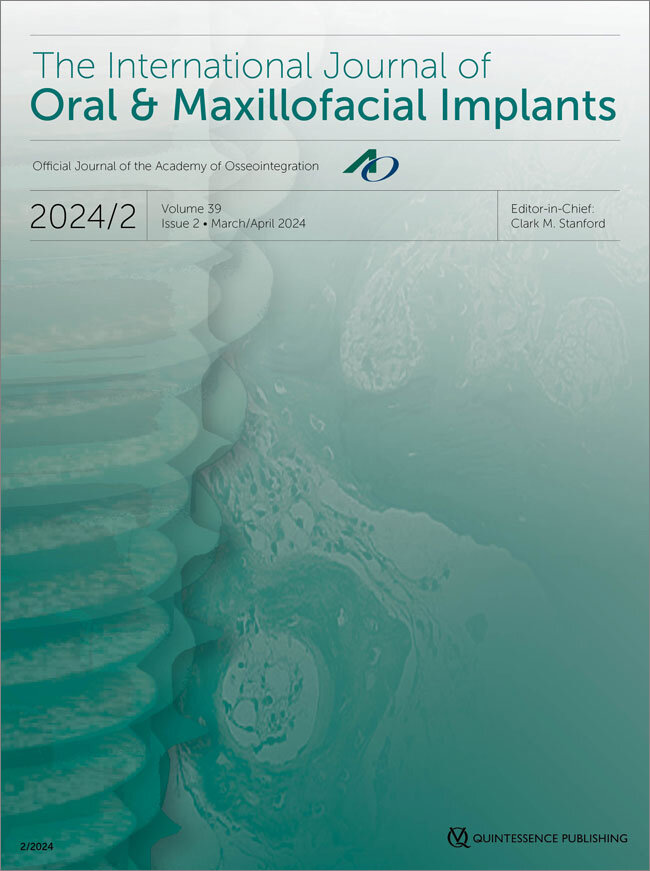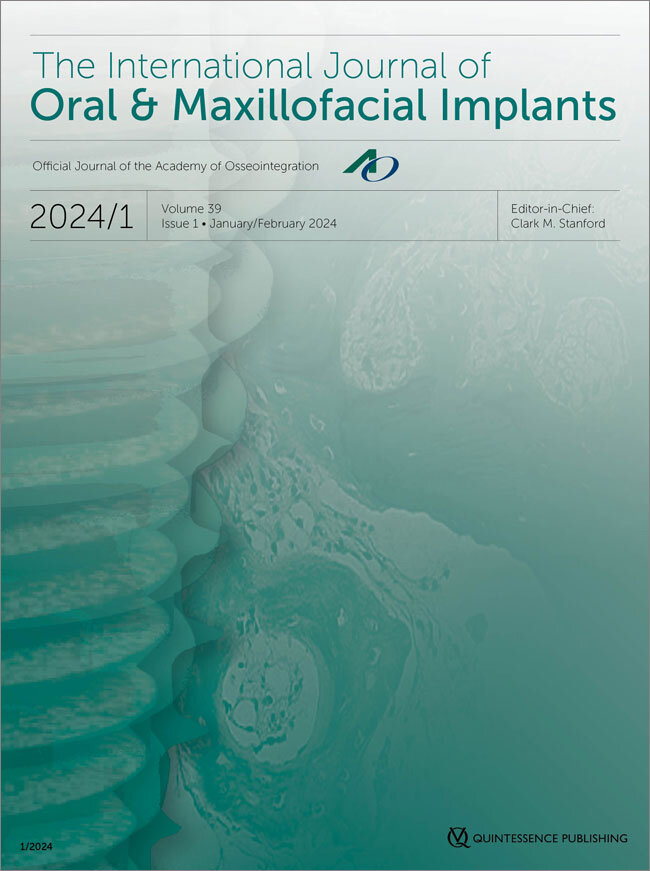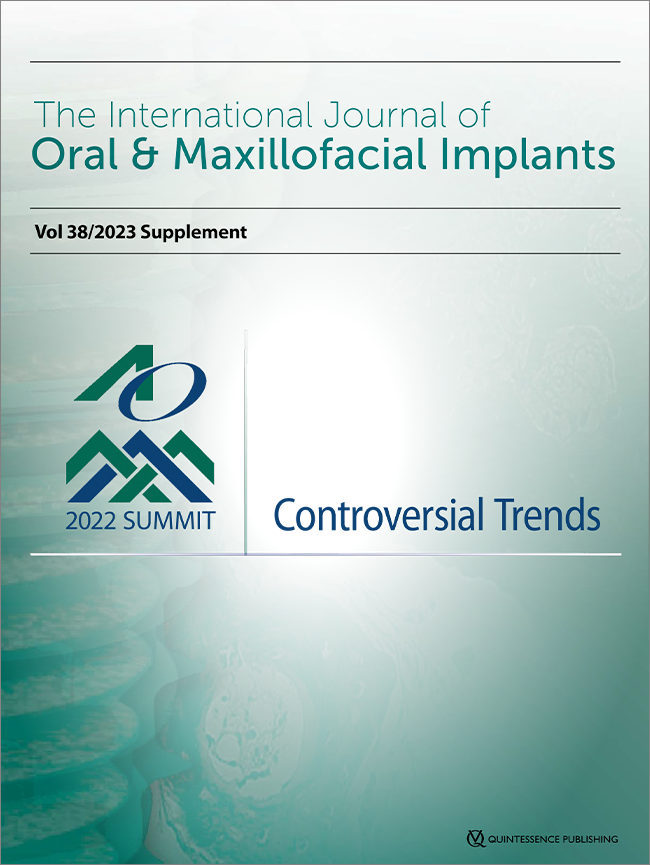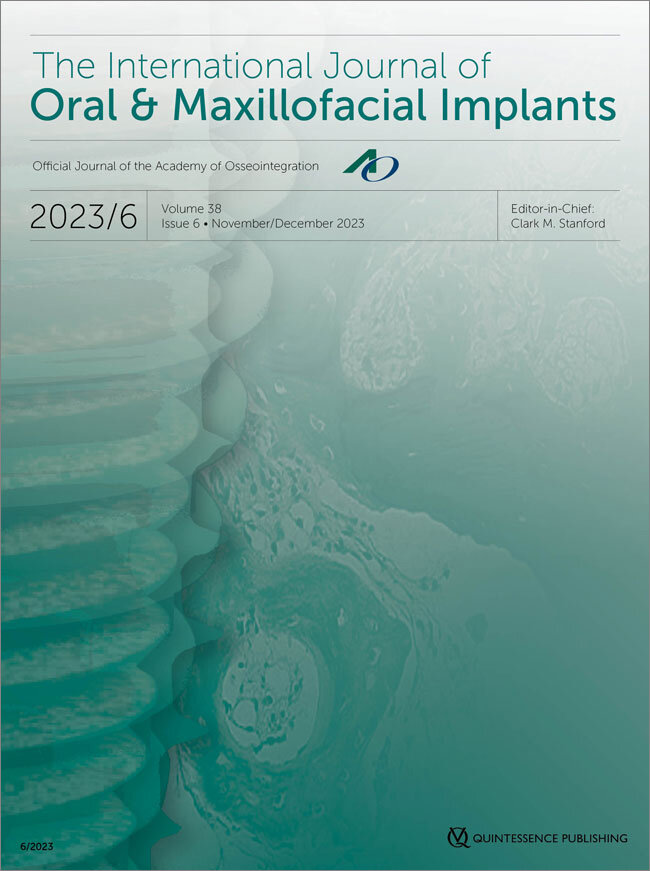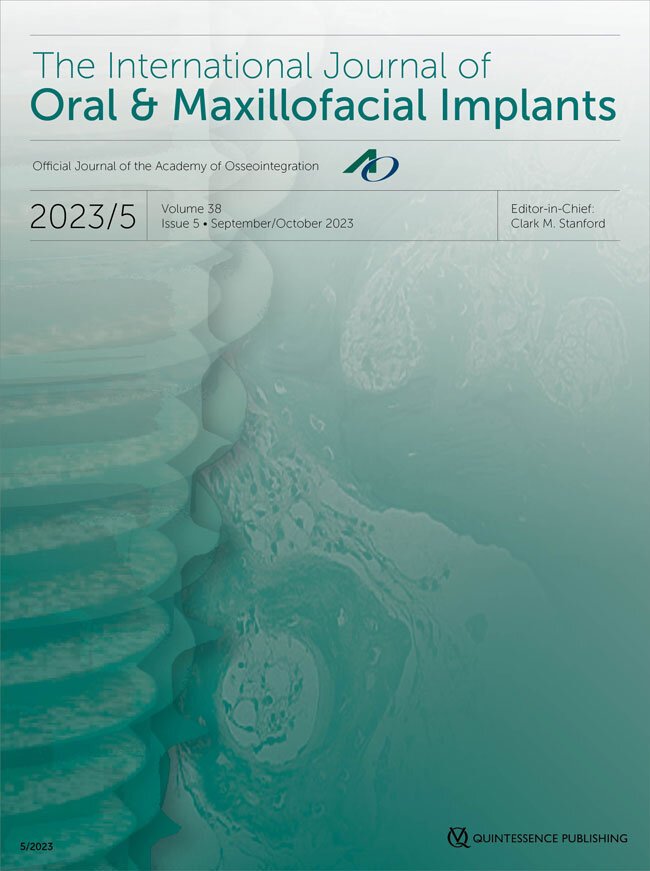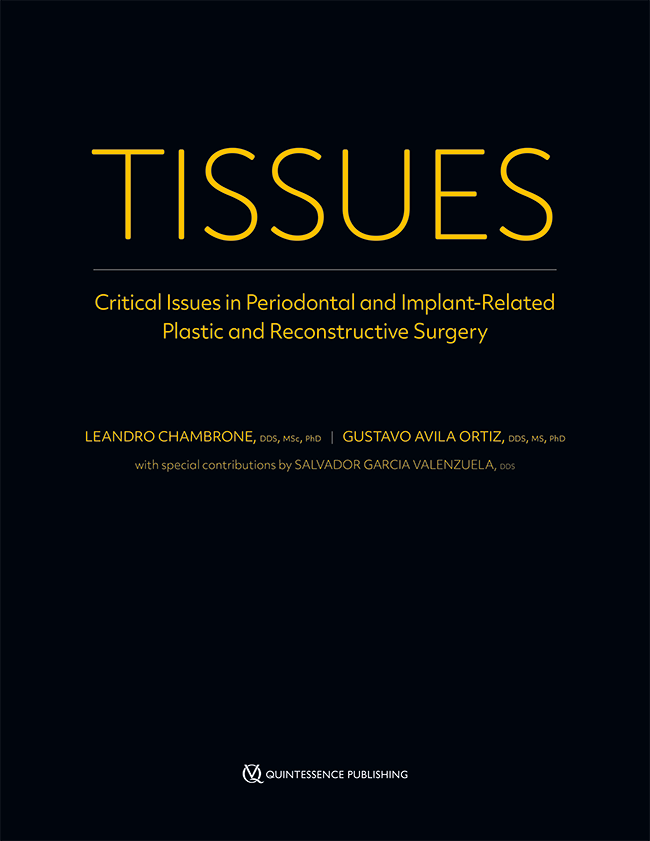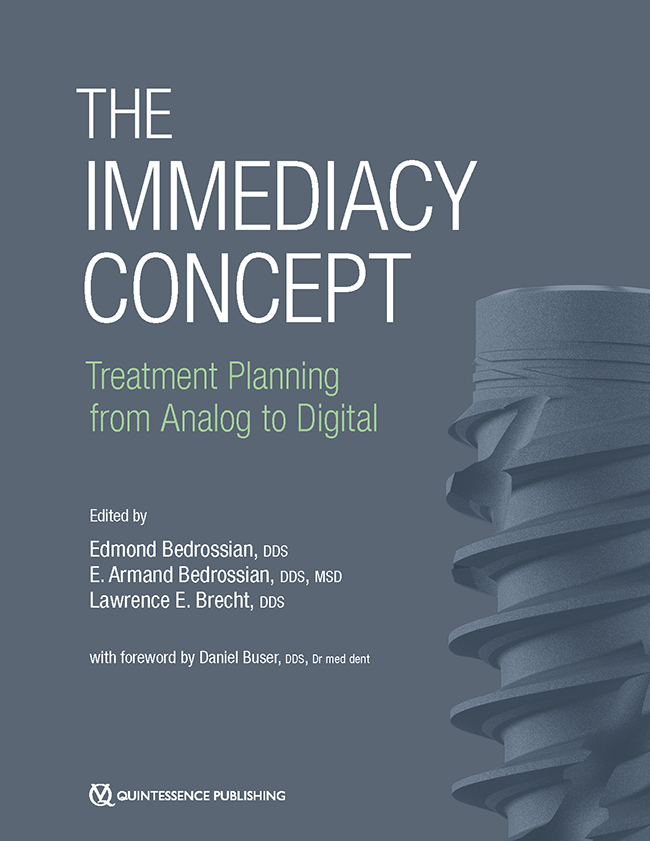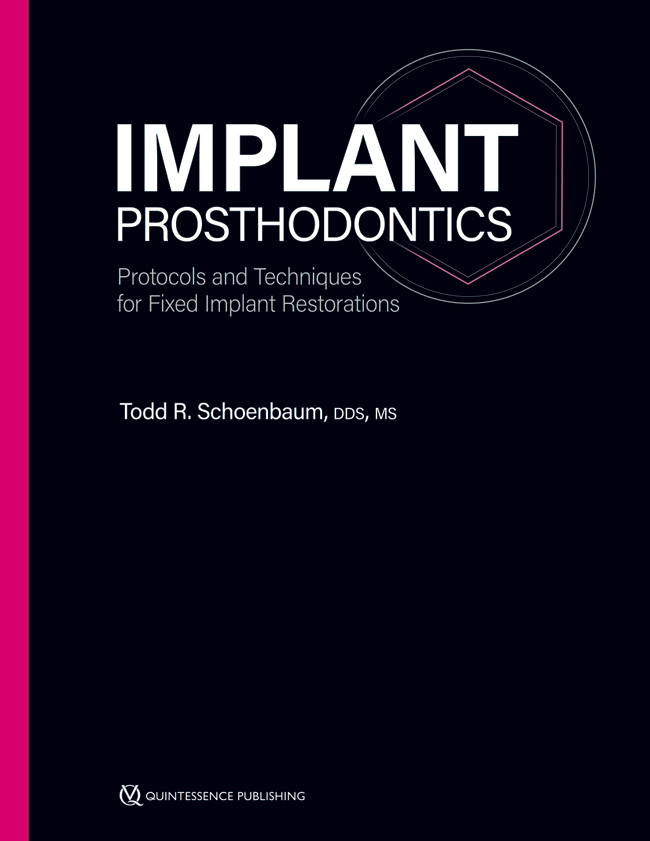PubMed-ID: 40198088Seiten: 140-140 , Sprache: EnglischStanford, ClarkEditorial DOI: 10.11607/jomi.11057, PubMed-ID: 39485908Seiten: 141-150l, Sprache: EnglischKalil, Eduardo C. / Cotrim, Khalila C. / Siqueira, Rafael / Moraschini, Vittorio / Faverani, Leonardo P. / Souza, João Gabriel G. / Shibli, Jamil A.Purpose: To gather information on the characteristics of implant osseointegration in animal models of induced osteoporosis to identify the role that some factors have in increasing the success rate in these situations. Materials and Methods: A systematic search in PubMed/MEDLINE, Lilacs, Cochrane Library, Scopus, and Web of Science was conducted to identify information between 2002 and 2023 regarding osseointegration of dental implants in animal models of induced osteoporosis. A standardized data extraction form was used to record data for each study, such as the article title, date, authors, number of animals, purpose of the study, type of analysis used by the authors, follow-up period, type of implants used, test and control groups, interventions, and conclusions. Results: A total of 204 articles were found for evaluation and selection. Out of the articles found, 43 were selected and evaluated based on the bone-to-implant contact percentage (BIC%) reported in them. Other parameters such as the bone-to-implant mechanical interface, bone area (BA), and bone volume (BV) ratios were also evaluated in the studies, if applicable. In the selected articles, a tendency for compromised results of implant osseointegration in the presence of osteoporosis was found. Both the modification of the implant surface as well as systemic and local use of antiresorptive drugs and other substances showed benefits for implant success in osteoporotic sites. However, there was still no observed consensus among studies regarding the superiority of systemic medications in improving the process of peri implant bone repair. Conclusions: Although it is possible to improve the osseointegration of implants in osteoporotic bone, either by using systemic or local factors, the metabolic bone syndrome caused by osteoporosis can jeopardize the osseointegration of dental implants.
Schlagwörter: bone, dental implants, implant surface modifications, osseointegration, osteoporosis, osteoporosis treatment
DOI: 10.11607/jomi.11048, PubMed-ID: 39316449Seiten: 151-161b, Sprache: EnglischLiu, Han-Pang / Chiam, Sieu Yien / Kakar, Era / Wang, Hom-LayPurpose: To investigate the clinical outcomes of xenogeneic bone blocks (XBBs) used for lateral ridge augmentation, specifically focusing on bone gain, graft survival, and implant survival. Materials and Methods: Data searches were conducted in PubMed, Embase, and ClinicalTrials.gov for randomized controlled trials (RCTs) and prospective cohort studies up to March 1, 2024. Horizontal bone gain (HBG), horizontal bone resorption (HBR), graft survival rates, and implant survival rates were analyzed. The Cochrane Risk of Bias Tool 2 (RoB2) and Newcastle-Ottawa Scale (NOS) were applied to assess the quality and risks of the included studies. Results: Four RCTs and five prospective cohort studies comprised a total of 120 bone graft sites and 141 implants that were included in the meta-analysis. A noncomparative analysis resulted in a weighted mean HBG of 4.38 mm and HBR of 0.85 mm. Comparative analysis with data from four RCTs compared XBBs with autogenous bone blocks (ABBs). The analysis resulted in a statistically significant greater HBG in XBBs, with a mean difference of 0.72 mm (95% CI = 0.067 to 1.382, P = .031, I2 = 28.2%). The weighted graft survival rate for XBBs was 91.3% (95% CI = 76.6% to 97.1%, I2 = 58.0 %), and the weighted implant survival rate was 84.3% (95% CI = 72.6% to 91.6%, I2 = 31.6 %). Histologically, the mean percentage of mineralized vital bone in XBBs ranged from 11.6% to 29.8%, and the resorption rate ranged from 7.3% to 21%. Conclusions: The use of XBBs for lateral ridge augmentation demonstrates an acceptable survival rate and yields an adequate bone volume for subsequent implant therapy. However, the survival rate of implants placed in ridges augmented with XBBs is less favorable when compared to those augmented with ABB grafts.
Schlagwörter: bone substitute, lateral ridge augmentation, meta-analysis, systematic review, xenogeneic bone block
DOI: 10.11607/jomi.11221, PubMed-ID: 40198089Seiten: 162-170, Sprache: EnglischNunes, Marta / Leitão, Bruno / Pereira, Miguel / Fernandes, Juliana Campos Hasse / Fernandes, Gustavo Vicentis de OliveiraPurpose: To verify whether the use of a “one abutment one time” (OAOT) insertion technique in dental implant treatment protocols significantly impacts clinical outcomes (ie, survival rates and success rates) and peri-implant indices (ie, survival rate, success rate, bleeding on probing, and marginal bone changes [MBC]) compared to conventional protocols. Materials and Methods: The protocol used in this review was developed according to PRISMA guidelines. The focus question was “In patients that are receiving a rehabilitation using dental implants, does the use of a OAOT technique have a better clinical performance compared to using provisional abutments?” The risk of bias (RoB) was performed using a modified version of the Cochrane RoB tool for randomized trials (RoB2, Cochrane Methods). A total of 554 articles were found in three databases (MEDLINE/PubMed, Scopus, and b-on). After screening them, 32 full-text articles were assessed for eligibility, and 11 randomized controlled studies (RCTs) published between 2010 and 2024 in the English language were included (κ = 0.98). Results: A total of 505 patients were included, with a mean age of 54 years; overall, there were more women than men (~ 58%). A total of 821 implants were included, with 397 implants in the test group (definitive abutment) and 424 implants in the control group (healing/provisional abutment). Follow-up periods ranged from 4 to 36 months. Five studies placed the implant shoulder at bone level, four studies placed it 0.5 to 2.0 mm below the bone crest, one admitted both placements, and another study did not disclose that information. The meta-analysis included 10 studies. The results showed a decrease in peri-implant vertical bone loss with the OAOT protocol compared to the conventional protocol at 6 and 12 months postoperative. Only one study exhibited a high RoB. Conclusions: Implementing the OAOT protocol with platform switching (PS) and higher abutments led to a decrease in bone loss compared to the conventional protocol; however, this reduction may not be clinically significant and might not improve esthetics.
Schlagwörter: bone loss, dental implant, marginal bone changes, one abutment one time, one-time abutment insertion
DOI: 10.11607/jomi.10958, PubMed-ID: 40198090Seiten: 171-180o, Sprache: EnglischJoshi, Vinayak M. / Hernandez, Katherine Carmona / M., Harsha / Chapple, Andrew G. / Shivanaikar, Sachin / Kandaswamy, EswarPurpose: To identify the top-cited articles in the field of sinus augmentation and to analyze the different bibliometric variables that impacted the citation of articles. Materials and Methods: A search was conducted in the Web of Science database and sorted to find articles that were cited at least 100 times. The articles were then screened by two independent investigators (S.S. and K.C.M.) for inclusion. The included articles were analyzed to generate (1) keyword and title word maps using the VOS viewer program, (2) author timelines and contributions using Bibliometrix, and (3) citation analysis data using the HistCite software (Informer Technologies). Then the data were analyzed for individual variables affected by citation counts using Quasi-Poisson regression, Wilcoxon signed-rank test, and Fisher’s exact test. Results: A total of 162 articles were included in the analysis. The number of references in each article was directly proportional and the journal impact factor and number of pages in the included articles were inversely proportional to the number of citations (P < .05). Note that authors from the USA had the highest number of publications within the collection. Conclusions: The top-publishing authors, countries, keywords, and title words were identified. It was observed that the number of references, the journal impact factor, and the number of pages of the included articles significantly impacted citation counts obtained by a given article.
Schlagwörter: biomaterials, bibliometric analysis, sinus augmentation, sinus elevation
DOI: 10.11607/jomi.11036, PubMed-ID: 39121361Seiten: 181-187, Sprache: EnglischKim, Heon-Young / Song, Ju-Dong / Jang, Il-Seok / Kim, Sun-Jong / Kim, Jin-WooPurpose: To investigate the impact of mineral oil lubricants used in rotary instruments on osseointegration within rabbit tibias with a specific focus on potential contamination from dental handpieces. Materials and Methods: A total of 12 New Zealand rabbits were included in this study, each receiving 2 implants in each tibia, resulting in a total of 48 implants across the study. Groups were organized based on the time until euthanasia and the degree of implant contamination. Three contamination levels were defined: The first group received implants without any lubricant in the handpiece (control group); the second group received implants with handpieces managed as recommended; and the third group received presoaked implants that were placed via a handpiece treated as per the second group’s protocol. These groups were further subdivided based on euthanization periods of 2 and 4 weeks. Both the removal torque and the bone-to-implant contact (BIC) were measured and analyzed. Results: No significant correlation was observed between the degree of implant contamination and removal torque. However, there was a significant reduction in BIC associated with higher contamination levels, particularly after 4 weeks. Conclusions: Even brief exposure to lubricants from handpieces can jeopardize the osseointegration of implants in bone. Therefore, it is imperative to implement thorough procedures for lubricant removal after application and to employ precise cleaning and suction during implant drilling and placement to minimize residual oil on the implant surface.
Schlagwörter: dental implant, lubricant, osseointegration, surface contamination
DOI: 10.11607/jomi.10574, PubMed-ID: 39485909Seiten: 188-196, Sprache: EnglischHenn, Paul / Gehrke, Peter / Happe, Arndt / Neugebauer, JörgPurpose: To conduct a retrospective study on the marginal bone level (MBL) of reduced diameter implants (RDIs) to analyze them in the context of various surgical and prosthetic treatment strategies using heterogeneous data from a private practice. Materials and Methods: A total of 123 patients were treated with 326 implants. Of those implants, 247 of them were RDIs, and the remaining 79 implants were standard-diameter implants (SDIs) as patient-related controls. The mean observation time was 24.4 months, and the maximum observation time 76.0 months. The peri-implant bone level of the implants was evaluated, while considering the diameter, time of implant placement, time of loading, extent of augmentation, and localization of the implants. The data were evaluated after restructuring using a mixed model analysis. Results: No significant difference was found between the use of RDIs or SDIs in the analyzed indications. Furthermore, no significant difference was found for the implant placement time, loading time, or the use of two-stage augmentations regarding the stability of the peri-implant bone level. Conclusions: Reduced-diameter implants are a sufficient treatment option in horizontally deficient bone conditions. The use of RDIs in the posterior region shows promising results; 3.5-mm- diameter implants may be indicated considering the individual patient situation. The use of a mixed model analysis for the evaluation of heterogeneous practice data can lead to a significant increase in the number of retrospective studies and data integration from practices, forming a sound basis for evidence-based dentistry.
Schlagwörter: bone augmentation, dental implants, implant diameter, marginal bone level, mixed model analysis
DOI: 10.11607/jomi.11004, PubMed-ID: 40198091Seiten: 197-206, Sprache: EnglischRyu, Dong-Su / Lee, Jae-Kwan / Um, Heung-Sik / Lee, Jong-BinPurpose: To compare survival rates and the marginal bone loss (MBL) of implants placed in patients with one-stage or two-stage maxillary sinus augmentation via the lateral window approach (MSALW) using only deproteinized bovine bone mineral (DBBM). Materials and Methods: The dental records and radiologic data of patients who had implants placed with MSALW were collected. The patients were divided according to the one-stage and two-stage MSALW, and the survival rate of each group was measured using the Kaplan-Meier method. The MBL of each group was measured through periapical radiographs at each defined time period. Statistical analysis of the differences between groups was conducted through the log-rank test and one-way analysis of variance (ANOVA). Univariate and multivariate regression tests wereperformed to analyze the degree of influence the interested variables had on the implant survival rate. Results: There was no significant difference in the 5-year cumulative survival rates between the one-stage and two-stage MSALW at the implant level (91.0% and 90.6%, respectively; P = .201) or at the patient level (89.7% and 89.7%, respectively; P = .330). There was a slight difference in MBL at the initial time point, but there was no significant difference for the total period (P = .289). Diabetes was found to have a negative effect on implant survival (P = .015; hazard ratio [HR] = 3.669). Conclusions: There was no significant difference in the 5-year cumulative survival rate or the 2-year MBL of implants between the one-stage and two-stage MSALW using DBBM.
Schlagwörter: alveolar bone loss, dental implants, retrospective study, sinus floor augmentation, survival rate
DOI: 10.11607/jomi.11039, PubMed-ID: 38941168Seiten: 207-217, Sprache: EnglischGehrke, Peter / Pietruska, Maria Julia / Korth, Anissa / Schöttler, Tanja / Jenatschke, Rafaela / Fischer, Carsten / Sader, Robert / Weigl, PaulPurpose: To retrospectively evaluate the long-term clinical, technical, biologic, and esthetic outcomes of implant-supported single zirconia crowns (ISCs) intraorally cemented to titanium-base (Ti-base) hybrid abutments up to 16 years after placement. Materials and Methods: A total of 63 ISCs were evaluated in 36 patients at two different private practices.Original Ti-bases were selected, and zirconia (Zr) mesostructures and Zr crowns were designed using CAD/CAM software and then milled from partially stabilized Zr blocks. After the mesostructures were cemented extraorally onto the Ti-bases, the Zr crowns were intraorally luted to the hybrid abutments. The Ti-base ISC restorations were followed for up to 16 years, and their clinical, biologic, and esthetic outcomes were recorded at distinct time points at 3-year intervals: October 2019 (T1) and October 2022 (T2). Results: A total of 36 patients (18 men, 18 women) received 32 ISCs in the anterior region and 31 ISCs in the posterior region of the maxilla and mandible. The mean follow-up of the Ti-base ISCs was 6.93 ± 2.60 years. The mean follow-up of the implants amounted to 8.11 ± 3.26 years. No implants were lost during follow-up, resulting in a cumulative implant survival rate of 100%. Abutment screw loosening was observed in two ISCs after 1 year of function. The overall cumulative restorative survival rate of the Ti-base restorations was 96.83%. At the T2 follow up, 24% of the ISCs exhibited an increase in probing depth (PD) despite maintaining clinically healthy peri-implant tissue. An 11% increase in bleeding on probing (BoP) and a 3.17% decrease in the plaque index (PI) were recorded. Despite spectrophotometrically measured ΔE values indicating visible discoloration of some restorations and their peri-implant soft tissue, a low incidence of esthetic complications was observed with an average pink and white esthetic score (PES/WES) of ≥ 12. No correlation was found between PES (R = –0.25; P = .27) and WES (R = –0.18; P = .43) scores and digital shade determination. Conclusions: The results indicate satisfactory clinical outcomes for intraorally cemented ISCs supported by Ti-base hybrid abutments. An overall esthetic superiority of Ti-base ISCs could not be confirmed.
Schlagwörter: retrospective trial, titanium base, zirconia, two-piece hybrid abutment, implant-supported single crown.
DOI: 10.11607/jomi.10956, PubMed-ID: 39172500Seiten: 218-228, Sprache: EnglischAsik, Batuhan / Ayyildiz, Berceste Guler / Terzioglu, Busra / Eken, SeymaPurpose: To evaluate the relationship between risk profile assessments of dental implants that have been in function for at least 2 years and peri-implant marginal bone loss during the follow-up period using the Implant Disease Risk Assessment (IDRA) diagram. Materials and Methods: A total of 70 patients, with 170 implants that had been functionally loaded for at least 2 years, had to attend follow-up sessions to be included in the study. Full-mouth plaque index (PI), gingival index (GI), probing depth (PD), bleeding on probing (BoP), and clinical attachment level (CAL) were recorded. Other parameters were also recorded, including peri implant modified plaque index, modified bleeding index, keratinized mucosa width (KMW), and gingival recession (GR). According to the IDRA risk diagram, participants and dental implants were divided into low-, moderate-, and high-risk groups. Marginal bone level (MBL) was measured on periapical radiographs obtained at functional loading (T0) and at the last follow-up session (T1), and mesial and distal marginal bone level changes (ΔMBL) were calculated as T1–T0. Results: A statistically significant correlation was found between the periodontitis history and periodontitis susceptibility regarding IDRA classification at the patient level. Full-mouth GI, PD, and BoP were found to be statistically higher in the high-risk IDRA group. No statistically significant results were found between the mesial and distal ΔMBL of the IDRA risk groups. Conclusions: The IDRA risk level increased especially by periodontitis susceptibility and periodontitis history, but no significant difference was found between risk groups in terms of ΔMBL.
Schlagwörter: disease susceptibility, periodontal disease, risk factors, peri‐implantitis, risk assessment, staging and grading
DOI: 10.11607/jomi.10957, PubMed-ID: 38657133Seiten: 229-240, Sprache: EnglischKomatsu, Keiji / Matsuura, Takanori / Ogawa, TakahiroPurpose: To test the hypothesis that surfaces of prosthetic implant abutments treated with vacuum ultraviolet (VUV) light enhance the growth and function of human gingival fibroblasts. Materials and Methods: Implant abutments were treated with 172-nm VUV light for 1 minute. Untreated abutments were included as controls. Their surface properties were characterized using scanning electron microscopy (SEM), contact angle measurements, and chemical composition analysis. Human gingival fibroblasts were cultured on both untreated and VUV-treated abutments to evaluate cell attachment, proliferation, distribution, and collagen production. Cell detachment assays were also performed under various mechanical and chemical stimuli. Results: After VUV treatment, the implant abutments demonstrated a notable transition from hydrophobic to hydrophilic wettability. Surface element analysis revealed a considerable reduction in surface carbon and increase in oxygen and titanium (Ti) elements on the VUV-treated surfaces. On day 1 of culture, 3.9 times more fibroblasts were attached on VUV-treated abutments than on untreated control abutments. Fibroblastic proliferation increased 1.9 to 3.1 times on VUV-treated abutments, along with a significant improvement in the distribution of populating cells. Collagen production on VUV-treated abutments increased by 1.5 to 1.7 times. While untreated abutment surfaces showed voids and a limited spread of collagen deposition, dense and full coverage of collagen was observed on VUV-treated abutments, with a great contrast in the challenging axial surface zone. Cell retention against mechanical and chemical detaching stimuli was increased 11.3 and 4.3 times, respectively, by VUV treatment. Conclusions: Treatment of implant abutments with VUV light for 1 minute resulted in a reduction of surface carbon and a transformation of the surface from hydrophobic to hydrophilic. This led to enhanced attachment, proliferation, and retention of human gingival fibroblasts, along with nearly complete collagen coverage on implant abutments. These in vitro results indicate the promising potential of using VUV photofunctionalized implant abutments to enhance soft tissue reaction and sealing mechanisms.
Schlagwörter: gingival fibroblasts, implant abutment, photofunctionalization, soft tissue attachment, ultraviolet light
DOI: 10.11607/jomi.10998, PubMed-ID: 38941165Seiten: 241-249, Sprache: EnglischLevy-Bohbot, A. / Bertolus, C. / Durin-Touati-Sandler, Anne / Gellée, TimothéePurpose: To assess the advantages and disadvantages of the stackable guided approach through a retrospective analysis of 43 edentulous arches rehabilitated with or without bone grafts using a stackable guided approach and an immediate loading protocol. Materials and Methods: A total of 284 implants were placed with a fully digital workflow using stacked guides, which aided the design of provisional protheses loaded immediately after implant placement. The primary outcome measure was the survival rate of the implants at 4 months. Results: After a 4-month follow-up period, 10 implants (3.5%) exhibited no osseointegration and were subsequently replaced, resulting in an overall success rate of 96.5%. After 1 year of follow-up, a prosthetic success rate of 100% was observed, with all patients being able to progress to the permanent fixed dentures stage. Conclusions: Our findings support the use of this protocol for all patients, whether they require bone grafting or not. However, a long term follow-up is essential for a comprehensive evaluation of these treatment outcomes.
Schlagwörter: autogenous bone graft, completely edentulous, computer-guided surgery, immediate loading, full-arch rehabilitation, stackable guide
DOI: 10.11607/jomi.11010, PubMed-ID: 39093293Seiten: 250-256, Sprache: EnglischZhen Li, MM / Yun Yang, MBBS / Meng Yang, MM / Xin Tong, MDPurpose: To observe and analyze patients with dental implant fracture and explore the factors influencing the fracture to provide a frame of reference for clinicians. Materials and Methods: The clinical data of 19 patients with dental implant fracture who visited the Department of Implantology at Nanjing Stomatological Hospital between 2007 and 2019 were retrospectively observed and analyzed. Then the influencing factors of the fractures (eg, fracture location on the implant, implant diameter and connection mode, prosthetic method, and fracture site in the mouth) were analyzed and investigated. Results: The fractured implants comprised 12 Straumann implants (5 fractured at the smooth neck of the implant and 7 atop the central screws), 5 Bego implants (4 fractured at the smooth neck of the implant and 1 atop the central screw), 3 Lifecore implants (all fractured atop the central screws), and 1 Anthogyr implant (fractured atop the central screw). Of the 19 patients, 6 had anterior dental implant fractures, and 13 had posterior dental implant fractures (21 fractured implants in total). Maxillary anterior dental implant fracture was observed in 6 patients (8 implants), maxillary posterior implant fracture was observed in 3 patients (3 implants), and mandibular posterior dental implant fracture was observed in 10 patients (10 implants). Conclusions: A good implant system design, an appropriate implant diameter, and a reasonable maxillary prosthesis method are key to maintaining long-term stability of a dental implant.
Schlagwörter: cantilever fixed bridge, dental implant, implant diameter, implant fracture
DOI: 10.11607/jomi.11002, PubMed-ID: 38941171Seiten: 257-261, Sprache: EnglischWadhwani, Chandur P.K. / Albrektsson, Tomas / Schoenbaum, Todd R. / Chung, Kwok-HungPurpose: To investigate residual debris within internal features of new “as received” dental implants. Materials and Methods: A total of 15 new dental implants representing various dental implant brands were obtained in sealed containers from the manufacturers. Batch numbers and implant types were documented. In a controlled setting, implants were carefully unpacked, and their internal aspects were visually examined. Further analysis involved light microscopy imaging to document and photograph any foreign material. The internal aspect of the implants were sampled with both an endodontic paper cone and a fine bristle brush swab. These were inserted into the implant, rotated three times, then removed and examined under a microscope at 30× magnification. After sampling, some of the brushes and swabs were washed with alcohol to remove debris that could be further examined under magnification. Results: Inspection of the implants without magnification revealed no visible foreign materials. However, under light microscopy (10× and 30×), all 15 implants exhibited small black particles at various internal sites, including connections, threads, and deep within screw channels. Swabs evaluated at magnification detected what appeared to be metal particles in all 15 implants, ranging from distinct metal shards to smaller particles. Conclusions: This study suggests that implant manufacturers have not effectively removed all machining debris from within implant bodies, potentially producing prosthetic and clinical complications.
Schlagwörter: biomaterials, biomechanics, machining debris, microsurface, surface





